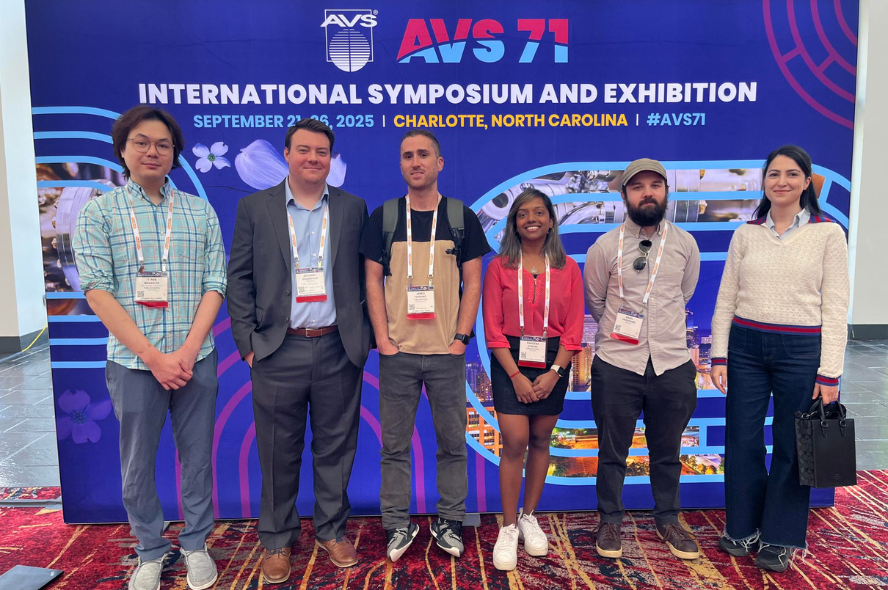Tufts researchers present work at AVS 71

By Celine Gomes
Six Tufts researchers recently participated in the American Vacuum Society 71st International Symposium and Exhibition (AVS71), one of the biggest gatherings in vacuum science and technology. Postdoctoral scholar Merve Baksi, Zachary Kranefeld, EG25, and Ph.D. candidates Kareena Guness; Pan Menasuta, James (Jimmy) Rushing and Basil Vanderbie showcased Tufts research at the event.
The conference draws more than 200 companies and leading researchers to highlight advances shaping the future of materials, manufacturing, and innovation. This year’s symposium was held in North Carolina with the theme: “Engineering the Future: Collaborative Frontiers in Surface, Quantum, and Energy Sciences” and featured presentations on emerging topics related to materials, processing, and interfaces.
For Menasuta, presenting at AVS71 marked both a milestone and a glimpse into the future of semiconductor research. His work explores how to fine-tune the surfaces of materials so the next generation of electronic devices can be faster, smaller, and more efficient. In his latest project, he discovered a way to smooth and stabilize the growth of semiconductor films, a finding that could open doors to stronger and more adaptable technologies. “I’m proud of this work because fundamental surface engineering can help expand the epitaxial process window for other semiconductor materials, which is increasingly important for smaller, more efficient photonic and electronic devices.” Menasuta said.
For Kranefeld, the AVS71 conference was as much about connecting with people as it was about sharing cutting-edge science. “My favorite part of the conference was networking with new people and exploring a new city,” he said. Kranefeld presented his research on fabricating optical metasurfaces in iridium, enabling new applications in extremely high temperature environments. His talk earned him the Advanced Surface Engineering Division Rising Star Award, a distinction from the AVS that highlights emerging leaders in the field.
One of the most valuable aspects of AVS71 was getting a glimpse into what comes next, according to Guness. “I had the chance to learn about what day-to-day life looks like for Ph.D. holders working in industry, academia, and national labs,” she said. “These conversations and insights were very helpful in giving me a clearer picture of what life after Tufts will look like.” Guness also presented her team’s research on fabricating silicon nanopillars—tiny structures that serve as the building blocks of nanotechnology—using a specialized electron beam lithography resist.
Baksi echoed the importance of these real-world experiences. “Conferences are especially valuable for early-career scientists like myself, and I appreciate the support from Associate Professor [Paul] Simmonds and the Tufts ECE Department in making these opportunities possible,” she said. At the symposium, Baksi showcased her work on the molecular beam epitaxy growth of a Bi-based InAsBi ternary system, a material with potential applications in topological insulators—an emerging class of quantum devices.
The presenters conduct research in two Tufts labs: the Renewable Energy and Applied Photonics (REAP) Lab and the Quantum Nanomaterials (Q-Nano) Center. At REAP Labs, led by Professor and Chair Tom Vandervelde of the Department of Electrical and Computer Engineering, researchers explore how light interacts with matter and translate those insights into next-generation technologies for image detection and energy independence. At Q-Nano, directed by Associate Professor Paul Simmonds, students study novel electronic and photonic nanomaterials, including quantum light sources, topological materials, and infrared optoelectronic devices, advancing both fundamental science and real-world applications.
Department:
Electrical and Computer Engineering